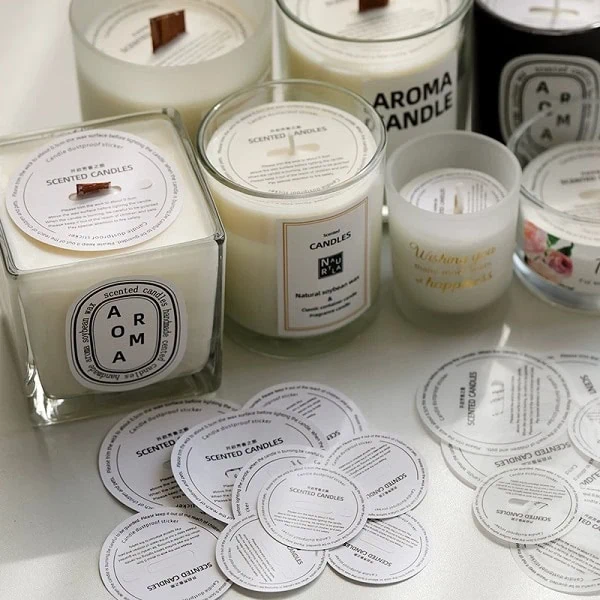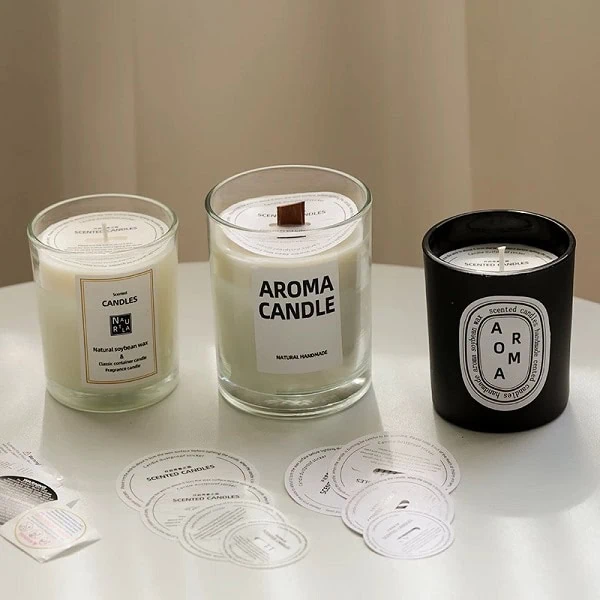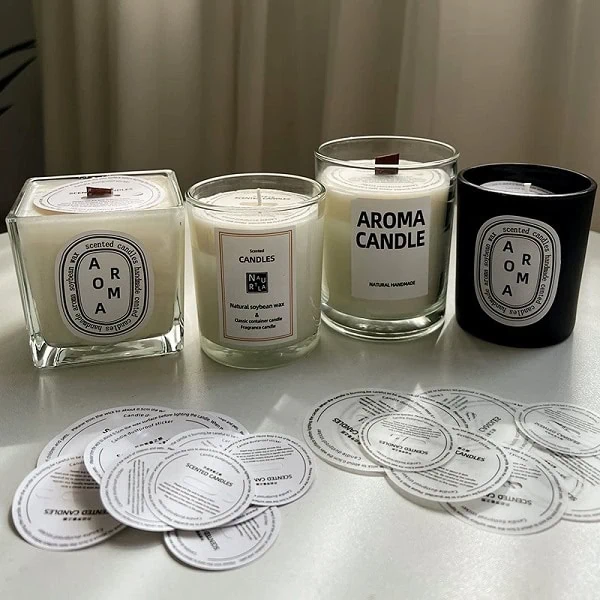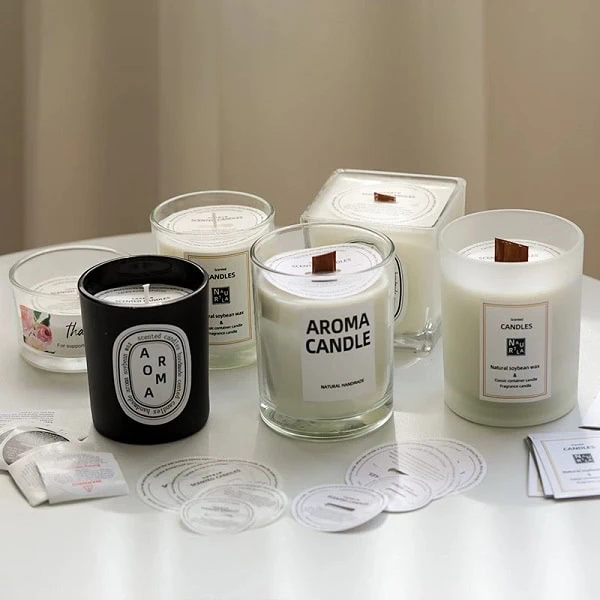Are you tired of your beautiful candle jar turning black? Do you wonder why there is soot all over your wax? You’ve come to the right place.
Candle soot is caused by incomplete combustion, where the wax isn’t burning completely. This leaves behind tiny carbon particles that float up and stick to the jar. Common causes include a wick that’s too long, poor quality wax, or drafts near the candle.

When I first started in the glass bottle industry, I saw countless factories making jars for candles. Over time, I learned that a perfect jar is just one part of a great candle. The wax, the wick, and even the environment all play a huge role in how a candle burns. I’ve learned a lot about why candles act the way they do, and I want to share some of that with you.
Why is my candle sooty?
Do you see black smoke coming from your candle? Is your room filling with a strange smell? You are not alone.
Soot from a candle is a sign of incomplete burning. This happens when the flame does not get enough oxygen to burn all the wax molecules. Instead of turning into carbon dioxide and water, some of the carbon from the wax turns into soot. This soot floats in the air and sticks to surfaces, including the candle jar.

When I was a young man working at the glass factory, I spent a lot of time on the production floor. I saw how every detail of a glass jar was important, from the thickness of the glass to the shape of the opening. It’s similar with a candle. The wick is the heart of the candle. If the wick is too thick or too long, it will pull up more wax than the flame can burn. This creates a bigger flame that flickers and smokes, producing soot. Think of it like a car engine running on too much fuel. The engine can’t burn it all, so it creates a lot of smoke. To prevent this, you must trim your wick. I have found that trimming the wick to about a quarter-inch before each use helps a lot. It makes the flame smaller and more stable. The type of wax also matters. Natural waxes like soy or beeswax tend to burn cleaner than paraffin. Paraffin wax is a byproduct of petroleum and can produce more soot. Finally, the environment around the candle is important. If you have a fan on or an open window, a draft can make the flame unstable. A flickering flame is a sooty flame. The constant movement prevents the flame from burning the wax completely. I have seen this many times. It is why you must place your candle in a spot with no moving air. To make it easier, here is a breakdown.
| Cause of Soot | What Happens | How to Fix It |
|---|---|---|
| Long Wick | The wick pulls up too much wax, creating a large, unstable flame that produces black smoke. | Always trim the wick to 1/4 inch before you light it. |
| Poor Wax Quality | Some waxes, especially paraffin, contain impurities that do not burn cleanly, leading to soot. | Choose candles made from cleaner-burning waxes, like soy or beeswax. |
| Drafts | Moving air makes the flame flicker and causes incomplete combustion. | Place the candle away from fans, open windows, or air vents. |
| Too Much Fragrance | Too much fragrance oil can overwhelm the wax, affecting how it burns and causing soot. | Choose candles from reputable brands that use a balanced amount of fragrance. |
Why does my candle jar turn black?
Do you feel frustrated seeing your beautiful new candle jar get stained with black residue? Are you wondering what you can do about it?
The black residue on your candle jar is soot, which is unburned carbon particles. These particles are a byproduct of incomplete combustion. The soot particles are light enough to float up and stick to the cooler inner walls of the jar. This is a common problem with container candles.

I have seen many jars and containers in my career at WXglass. A glass jar is an important part of a candle. It holds the wax and creates a beautiful product. But it also creates a small, enclosed space for the flame to burn. When a candle burns, the air inside the jar gets hot and rises. New, fresh air with oxygen comes in at the bottom. This process, called convection, usually works well. But in a jar, it is a tight space. If the wick is not centered, the flame can get too close to one side of the jar. When the flame gets too close to the glass, it gets less oxygen on that side. This makes the flame burn unevenly and creates more soot. The soot particles then stick to the cool glass wall. This is a big problem for candle makers. Another issue is the size of the jar opening. A jar with a narrow opening can trap the hot air and not let fresh air in easily. This can lead to the flame not getting enough oxygen, causing it to produce more soot. When I was visiting a factory in China, I saw a new type of glass jar with a wider mouth. The owner told me it was designed to improve airflow and reduce sooting. It makes sense. Good design is everything. Also, as the candle burns down, the jar gets deeper. This can make it harder for air to get to the flame. This is why you will often see more soot build-up at the bottom of the jar. This is a very common issue that many people do not know about. To avoid this, you should keep your wick trimmed. This keeps the flame small and makes it easier for air to get to it, even in a deep jar.
Why is there black stuff in my candle wax?
Have you ever noticed black specks in your candle wax? Do you think your candle is dirty or spoiled?
The black specks in your candle wax are most likely soot that has fallen back into the melted wax pool. This happens when the candle’s flame produces more soot than it should, and these particles settle on the melted wax. This is a sign of an improperly burning candle.

When I first started in the business, I was very focused on the quality of the glass itself. I wanted to make the best glass bottles in China. But I quickly learned that the final product is a combination of many parts. A candle is the same. The wax, the wick, and even the fragrance must all work together. When a candle is burning well, the melted wax pool is clean and clear. The black specks appear when the flame is producing too much soot. This soot floats up, but some of it can fall back down into the hot wax. It looks messy and can clog the wick, which makes the problem even worse. It is a cycle that can ruin your candle. The most common cause is a wick that needs to be trimmed. If the wick is too long, the flame is too big and unstable. It burns more wax than it should and creates soot. The soot then falls into the wax. I have a client in the UK, Jules, who is very particular about quality. We always talk about how every detail matters. The black specks in the wax would be a big problem for him because it makes the product look cheap. To fix this, you must keep your wick trimmed. A short wick makes a smaller flame that burns more cleanly. Another reason is a candle that has been burning for too long. After about four hours, the wax gets very hot and can start to burn too fast. This can also lead to more soot. It is a good idea to put your candle out after a few hours and let it cool down. It will make the candle last longer and burn better. I always tell my clients that quality is a long-term goal. The same is true for a candle. You must take care of it to get the best performance.
Do scented candles cause soot?
Do you love scented candles but worry they are the reason for all the black soot? Are you wondering if fragrance oils are the problem?
Yes, scented candles can cause more soot than unscented ones. The fragrance oils added to the wax can affect how the candle burns. Some fragrance oils can make the wax burn hotter or faster, which can lead to incomplete combustion and more soot. Not all scented candles are the same, however.

In my experience, working with different clients all over the world, I know that every small detail can make a big difference. I had a client, Jules from the UK, who was very concerned about the quality of the juice bottles we made for him. He wanted to make sure they were perfect. The same is true for candles. The fragrance is a crucial part of a scented candle. People love the smell. But the oils used to create that smell can be a problem. When a candle burns, the wick pulls up the melted wax. The flame then turns the liquid wax into a gas and burns it. Fragrance oils are also pulled up and burned. Some fragrance oils have a heavy chemical makeup. These oils can change how the wax burns. They can make the flame burn at a different temperature. Sometimes, the oils do not burn cleanly. This leaves behind carbon particles, which are soot. So, a candle with a high concentration of fragrance oil is more likely to create soot. This is a technical detail many people do not know. It is not just about the smell; it is about the chemistry. I have learned to appreciate these technical details in my work. The quality of a product is in these small things. The best candle makers use high-quality fragrance oils that are meant for candles. They also use the right amount of oil. If they add too much oil, it can overpower the wax and make the candle burn poorly. This is why you should buy candles from trusted companies that know what they are doing. They will have tested their candles to make sure they burn cleanly. When I was helping my clients find the right glass bottles, I always told them to look at the certifications. It is a sign of quality. It is the same for candles. Look for a brand that shows its quality.
Conclusion
A sooty candle is a sign of incomplete burning, caused by a long wick, drafts, or fragrance oils. Trim your wick, place your candle away from drafts, and choose high-quality brands.

